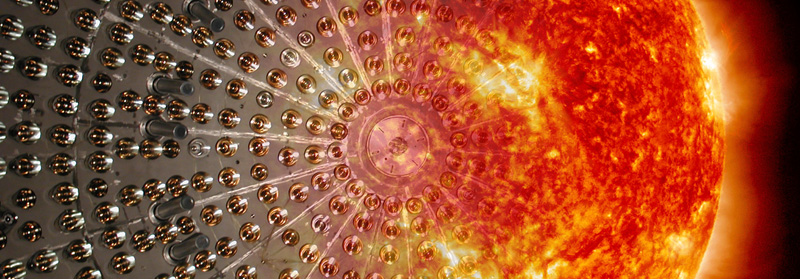
Abstract
Borexino is a particle physics experiment located in Hall C of the Laboratori Nazionali del Gran Sasso, approximately 100 miles north-east of Rome - Italy. It is a large liquid scintillator detector whose main goal is the study of the properties of low energy solar neutrinos and has started data-taking in 2007. The exceptional levels of radiopurity Borexino has reached through the years, have made it possible to accomplish not only its primary goal but also to produce many other interesting results both within and beyond the Standard Model of particle physics.
Description
The fusion processes that generate the Sun’s energy take place in the core, its innermost part. Lots of photons and neutrinos are produced there. While photons are stopped in the Sun core and the relative energy takes typically a million years to reach the Sun’s surface (and us), neutrinos emitted in the fusion reactions are able to traverse the material of the Sun (mostly ionized hydrogen and helium) and arrive in 8 minutes (travelling at the speed of light) to the Earth’s surface.
This is possible because of a feature that makes the neutrino peculiar in yet another sense: its interaction capability with matter (called cross section) is unbelievably small (~ 10-46 cm2) . Most of the neutrinos traverse the Sun and the Earth with almost no interactions at all.
It is precisely inside a huge detector like Borexino that an impressive compensation takes place between an unbelievably small number (the neutrino cross section, 10-46 cm2) and an incredibly large number (the solar neutrino flux, ~ 1010 cm-2 s-1) to produce a number which is still rather small (~ 10-36 interactions per second per unit target) but can be made reasonable by having a big (several tons) detector (tons of material, so that one has about 1030 targets). The detector features about 1300 tons of scintillator and 2400 tons of water.
![]()
However, the investigation of the solar neutrino spectrum is far from being an easy game. The background is a very important experimental problem that makes neutrino detection very difficult. The background has several components but the main ones are the radioactivity of the detector materials, of the Gran Sasso facility and cosmic ray particles.
Especially in the energy region below 1 MeV, experiments can be severely affected by background: in particular, the cosmic ray background practically imposes the use of an underground laboratory to shield the detector. In the Gran Sasso underground laboratory, the average rock cover of about 1,400 m results in a reduction (with respect to the surface) in the muon flux of a factor 106. To give an idea, the expected rate of 7Be solar neutrinos in 100 ton of Borexino scintillator is about 10-9 Bq/Kg while the common natural water is about 10 Bq/Kg in 238U, 232Th and 40K.
The Borexino experiment started taking data in 2007. Since then, it has produced a considerable amount of interesting results which include the first direct spectroscopy of proton-proton solar neutrinos, the precision measurement of the 7Be solar neutrino rate (with a total error of less than 5%), the first direct measurement of the so-called pep solar neutrinos and the measurement of the 8B solar neutrino rate with an unprecedented low energy threshold. Borexino has also published significant results on non-solar neutrino physics, such as the first observation of anti-neutrinos from the Earth (the geoneutrinos) and several limits on rare or forbidden processes.
Collaboration
ITALY
INFN Genova: Alessio Caminata, Massimo Cariello, Stefano Davini, Lea Di Noto, Marco Pallavicini, Gemma Testera, Sandra Zavatarelli
INFN LNGS: Riccardo Biondi, Paolo Cavalcante, Attilio Di Giacinto, Valentino Di Marcello, Chiara Ghiano, Augusto Goretti, Aldo Ianni, Matthias Laubenstein, Massimo Orsini, Maria Teresa Ranalli, Alessandro Razeto, Nicola Rossi, Roberto Tartaglia
INFN Milano: Davide Basilico, Gianpaolo Bellini, David Bravo, Augusto Brigatti, Barbara Caccianiga, Davide D'Angelo, Marco Giammarchi, Paolo Lombardi, Emanuela Meroni, Lino Miramonti, Sergio Parmeggiano, Gioacchino Ranucci, Alessandra Re, Paolo Saggese
Università di Perugia, Dipartimento di Chimica, Biologia e Biotecnologie: Fausto Ortica, Nicomede Pelliccia, Aldo Romani
INFN Ferrara: Giovanni Fiorentini, Fabio Mantovani, Barbara Ricci, Virginia Strati
CFDLab@Energy - Department of Energy - Politecnico di Milano: Fabio Inzoli, Riccardo Mereu
Università di Napoli: Yura Suvorov
FRANCE
AstroParticle & Cosmology Laboratory (APC): Davide Franco
GERMANY
Forschungszentrum Jülich: Zara Bagdasarian, Sindhujha Kumaran, Livia Ludhova, Luca Pelicci, Omer Penek, Mariia Redchuk, Giulio Settanta, Apeksha Singhal
JGU Mainz, Institut für Physik: Daniele Guffanti, Johann Martyn, Michael Nieslony, Vsevolod Orekhov, Alessio Porcelli, Michael Wurm
Technische Universität Dresden: Mikko Meyer, Jan Thurn, Kai Zuber
Technische Universität Muenchen: Matteo Agostini, Konrad Altenmueller, Simon Appel, Dominik Jeschke, Birgit Neumair, Lothar Oberauer, Laszlo Papp, Stefan Schoenert, Franz von Feilitzsch
POLAND
M.Smoluchowski Institute of Physics Jagellonian University Krakow: Anna Jany, Marcin Misiaszek, Marcin Wojcik, Grzegorz Zuzel
RUSSIA
JINR Dubna: Andrey Formozov, Oleg Smirnov, Albert Sotnikov, Alina Vishneva, Oleg Zaimidoroga
Kurchatov Institute: Victor Atroshchenko, Evgeny Litvinovich, Georgy Lukyanchenko, Liudmila Lukyanchenko, Igor Machulin, Radik Nugmanov, Georgy Raikov, Mikhail Skorokhvatov
Lomonosov MSU SINP: Alexander Chepurnov, Maxim Gromov
PNPI RAS Gatchina: Alexander Derbin, Ilia Drachnev, Ira Lomskaya, Valentina Muratova, Nelly Pilipenko, Dmitrii Semenov, Polina Shakina, Evgenii Unzhakov
UK
University of London: Gyorgy Korga
UKRAINE
INR Ukraine: Vladislav Kobychev
USA
Princeton University: Jay Benziger, Frank Calaprice, Antonio Di Ludovico, XueFeng Ding, Cristiano Galbiati, Andrea Ianni, Lidio Pietrofaccia
University of Massachusetts, Amherst: Andrea Pocar
Virginia Polytechnical Institute: Bruce Vogelaar
Recent publications
G. Bellini et al., Physical Review D, vol. 89, 112007 (2014).
G. Bellini et al., Physics Letters B, vol. 722, 295 (2013).
G. Bellini et al., Journal of High Energy Physics, vol. 8, 038 (2013).


